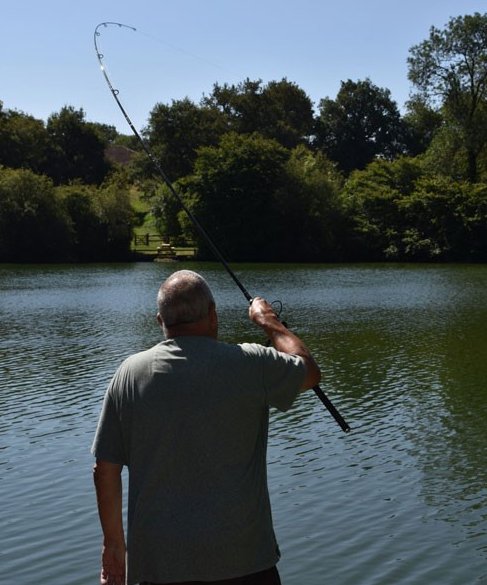
Tricks of the Tail: Advanced Fishing Techniques
Share
I hope you are managing to stay safe and sane during this coronavirus crisis. It's hard keeping ones sanity, and not being able to get out on the banks simply makes matters worse, as I well know.
Early in March I came into contact with a mate who had just come back from China. Little did I know it at the time but he had caught the virus and within a few days of coming home he went down with Covid-9. Me and Tat contacted NHS England to report the contact and we were immediately instructed to self isolate for two weeks and to report any Covid-19 symptoms that may develop. I am happy to say that none did, and, more importantly our mate recovered and returned home fit and well. Whew! Close call.
Confinement lifted we were delighted to be able to get out ourselves to celebrate my birthday so on the 20th March we went out for a beer at the local. Two days later #Stay at Home came into force so back into self-isolation we went. Since the beginning of March we have left out home for a total of four hours and by now cabin fever has set in.
We had been due to go to France on the 12th March but cried off after reading all the horror stories coming out of not just France but Italy in particular, which was now suffering badly. In hindsight I am glad in a way that we did call it off but had we decided to go we would now still be in lockdown in a wonderful gite on the banks of its own private carp lake. That would be a damn sight better that self-isolating here at home. To make matters even worse there is a juicy little carp lake less than a mile away…that we are not allowed to fish. We can jog around it (we don't jog) and could walk our dog around it (we don't have a dog) but I we wanted to relax by the waterside with a couple of rods out, well that would be forbidden…Arrrgh!
Of course there is an upside to this story as I can continue working from home and one of my projects is to produce a few Lockdown Blogs on various aspects of carp fishing.
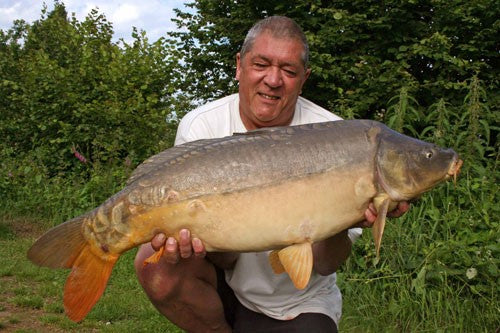
I have noticed of late a revival of interest in running leads, in particular, light running leads and slack lines. I hope by now there has been enough material published on line by luminaries of this esoteric art to point out that this way of fishing can only be practiced effectively with either heavy fluorocarbon line or thick heavy sinking braid on the reel. Monofilament lines simply are not heavy enough. You see, it is the specific gravity of the line that is important and the weight of water pressing on it is what creates the tension that allows this method to work so well.
In direct contrast to traditional running lead fishing, where a heavy lead acts as an anchor point through which the line runs, the "light, running lead on slack lines" method (aka slack lining) relies on the principles of fluid mechanics.
Now before I go any further on the science please do not confuse me with someone who know what he is talking about. However, I will say this: if it is good enough for Keith Moors, who runs the Moorlands fishery in France, then it is good enough for me. Keith refined and then developed the technique and his writings inspired me to try his slack line, light lead method, and I have used it wherever practical for nearly fifteen years.
Keith explains that fluid mechanics is the branch of physics concerned with the mechanics of fluids (get away!) and the forces on them. It's a deep and complicated subject involving algebraic equations, algorithms, vectors, perfect and negative numbers and a whole host of incomprehensible gobbledegook only egg heads like Keith can explain. In a nutshell the weight of water pressing down on a dense heavy line is sufficient to create tension such that a carp cannot fart at the business end of your line without you knowing it! I have practised slack lining since I first learned the mechanics of the method from Keith in 2006 and would not change it unless forced to do so at gunpoint!
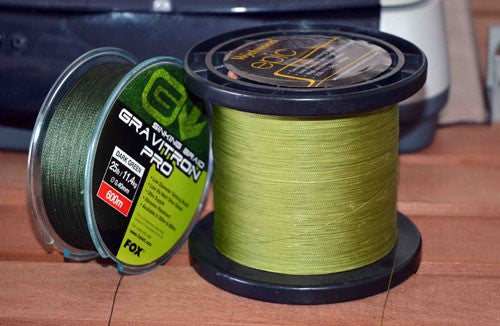
In this blog I want to talk specifically about slack lining with braid reel line. I have used several brands over the years: Fox, Wychwood, Berkeley, and PowerPro. All have their pros and cons: some don't sink as well as others, some are awful lines for casting and so on. So you'll see that I have had plenty of opportunity to search around for a good sinking braid that does what it says on the tin…Sinks! etc.
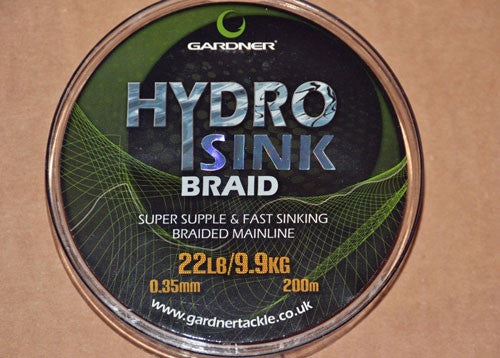
Hence I have finally settled on what is in my opinion the best sinking braid on the market at this time, namely Hydro-Sink from Gardner Tackle. This is a high strength, fast sinking, low diameter specialist braided main line that offers phenomenal strength and amazing durability for a braid. The combination of high strength core of Dyneema with a woven Kevlar fibre wrap creates a super strong braid that sinks superbly. Hydro-Sink lies flush to the lake bed for the most subtle line lay, an important consideration when fishing for pressured big fish. The application of a Teflon coating reduces friction and increases abrasion resistance. It also gives improved casting highest performance and helps protect the braid from general wear and tear.

Hydro-Sink is extremely low stretch; approximately 4%, compared to 5-6% on standard braided lines and over 20% on many nylon monofilament lines. This gives you much better bite indication and improved contact with the fish, especially at long range. This means that you can fish locked up when fishing to snags at long range, pulling/walking fish away from the snags if necessary. It has a stated breaking strain of 22lb and this is rated at minimum knot strength with either Grinner and Palomar knots. It is .35mm and in my own tests I have found that when wet it breaks well above Gardner's suggested breaking strain. It also makes playing carp even more of an exciting experience.
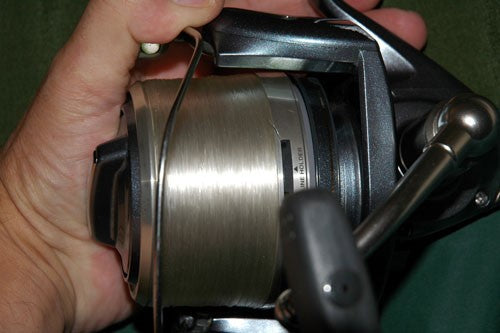
A decent alternative to braid is a fluorocarbon reel line. These also sink very well but they are nothing like as sensitive as braids and while they are much better than monofilament lines as far as slack lining is concerned, fluoros do have a couple of considerable drawbacks. The first is that they are as lively on the reel as a spitting cobra. Allow tension to relax for a split second and coils of line will leap from the reel to gather in a tangled heap at your feet. Secondly most fluoro lines are not what anyone would call casting lines. They retain a strong 'memory' which means that the line comes off the reel in tight coils, which cause line slap against the rod, which in turn reduces the distance you can cast. That said, I would far rather use a fluoro line than a mono if the use of a braid was not allowed. I have used several fluoros over the years from Fox, Berkley and Tiger but again my preferred fluoro comes from the Gardner stable. This is 16lb Mirage loaded on my Shimy.

Setting up with slack lined braid differs from the traditional method where you cast out, reel in so that you are tight to the lead, and then attach a heavy bobbin. With braid you cast out, allow the line to sink from lead to bank, and then pay off more line, watching at the tip to judge that it is all sinking nicely. Keep paying off line until it hangs limp at the tip. Only now should you add the bobbin.
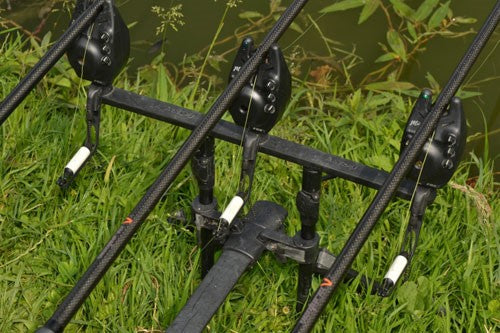
I like to use a fairly light bobbin for slack lining and the Gardner Nano Bugs are ideal. I use them in conjunction with a Nano Bug Cradle (an gizmo inspired by Keith himself). This keeps the bobbin close to the indicator head and stops it from lying on the deck where it might get trodden on or eaten by a mouse (joke!). Now you may be wondering, how can that work with dropback takes? Well here's the thing folks. If you fish slack line you simply don't get dropbacks! Think about it: the carp picks up the bait and is pricked lightly in the mouth It shakes its head trying to eject the hook but as there is comparatively little resistance from the lead the head shakes simply enhance the hook hold. Now spooked the fish takes off and it makes no difference which direction it takes. If it runs towards you (normally creating a dropback) the weight of the water on the heavy line is sufficient to lift the bobbin at your end. The line tightens gradually and you have plenty of time to get to the rod. Same applies if it runs off to the side or away from you.
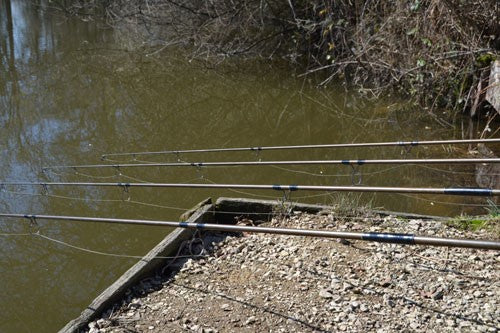
I fish so that the line hangs slackly between the rings.
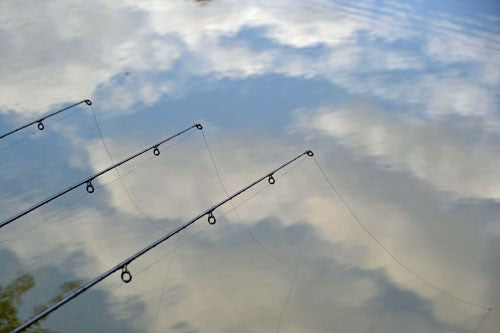
So slack, in fact, that it hangs almost vertically from the tip ring.

Using a lighter lead than normal allows it to skip across the bottom and follow the flight of the carp. As soon as you pick up the rod the hook is fully engaged and you can play the fish out to a successful conclusion. And don't concern yourself that you might not be able to cast the required distance with such a light lead. You'd be surprised at how far you can cast using braid. I can chuck a one ounce lead to a distance of at least 80 yards, and if I need to cast further I simply pop the end gear in a PVA bag to add casting weight.

To set up the slack line system on braid first you need to attach a safety leader. This helps protect the head and flanks of the carp during the scrap. If you used the braid straight through it would cut into the fish under tension. I use a 1.5m length of Gardner Tackle's 30lb Mirage Fluorocarbon, which I attach to the braid using n Albright Knot.
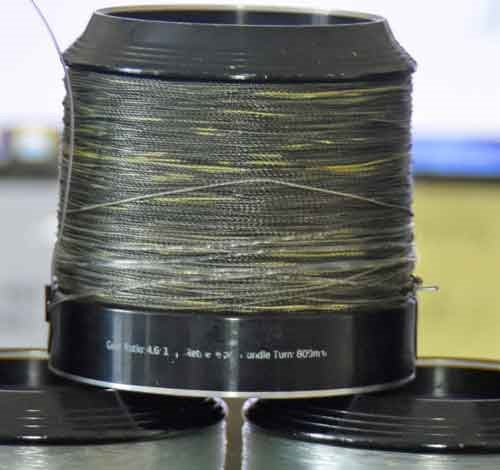
It is OK if you want to leave the leader in place between trips but check it to make sure that it is not abraded. Replace it if is shows any sign of abrasion. If you get pig's tail curls simply pull hard for a few seconds on each end of the fluoro leader. You will find it will hang straight once you have done that.

I like to guard against the lead becoming snagged in the bottom or weed or other snags so I use a break out set up from Enterprise Tackle called the Snag Safe Run Ring system. This involves attaching the lead to a specially designed C-Clip, which will open out to release the lead should it become snagged.
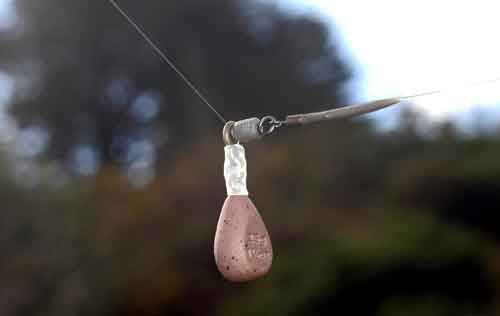
This shows my preferred set up for light lead slack lining.
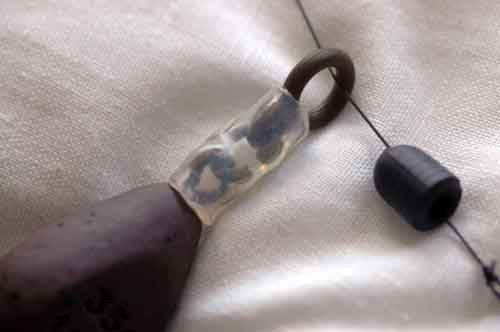
And this is a close up of the lead system.
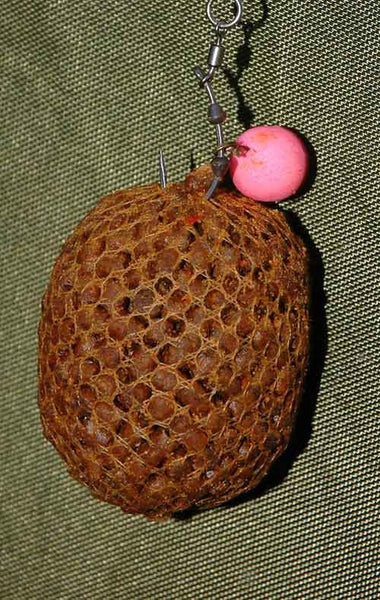
There are a number of advantages to using braid on your reels, not least of which is its sensitivity. This really comes into its own if you are fishing The Method, or a PVA bag or a dense carpet of seeds or grains. Imagine that you have cast out a tightly packed PVA mesh parcel of pellets to, say, 80m range.. You put the rod in the rests and after paying out the line so that it hangs slackly as shown above, you attach the bobbin. Now you sit back and start playing the waiting game…or do you? Well, yes, if you are using mono as it's unlikely you will be aware of what is happening out there in the lake at the business end, as mono is just too insensitive. On the other hand, if you have braid on the reels, when fish move in to feed on the scattered pellets after the bag has dissolved you will soon know what is happening out there as the line will twitch like mad as the fish suck and blow in the vicinity of the hookbait. You will also get a series on intermittent bleeps on the alarm as they feed. Yes, braid really is that sensitive.
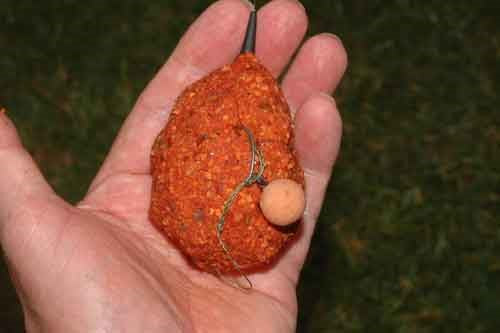
Similarly the same applies if you are using a Method feeder. This is a Method feeder packed with the highly attractive Three-In-One mix SuperRed.
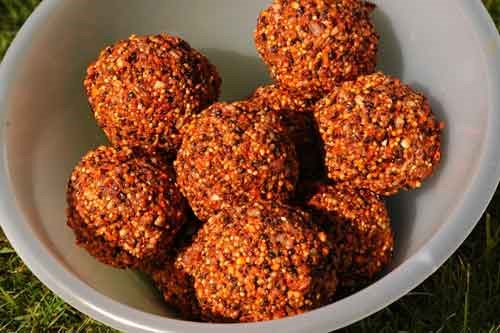
or if you are using groundbait to attract the carp into your baited area. Here you see a groundbait blend of SuperRed and prepared Oat Groats.
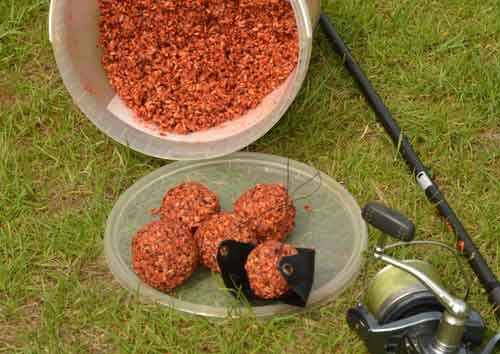
The bait is rolled into balls about the size of a Satsuma orange, which can then be fired out using a groundbait sling, as shown here. With a bit of practice you can put these out to 120m of more.

Once the line starts twitching and the alarm starts bleeping it's time to get ready for the take, for you can be sure that when a carp (or carp) is feeding that close to your hookbait a pick up is sure to occur any second! This is especially true if you are using any of our mini seed blends such as Red Band Pigeon Conditioner (shown here).
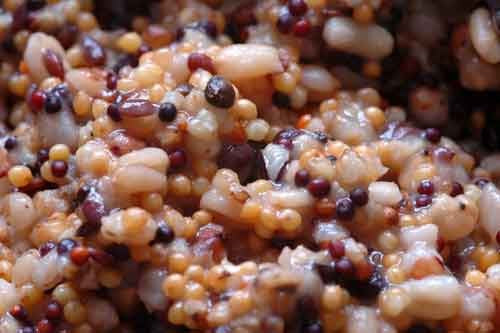
Other micro seed blends such as Micro Complex can also create absorbed and competitive feeding, and when the fish are competing for every last little item of food they will almost certainly grab the larger food item, which is your hookbait.
I am such a huge fan of using braid on my reels that I even avoid lakes that have a rule that bans it. Crazy? Yes, maybe. But I have actually managed to reverse the ill-informed opinions of fishery owners who ban it after they have watched me use it to my considerable advantage. I caught this gorgeous common from a lake that had a braid ban in place until I showed the fishery owner just how advantageous using braid can be. Give it a try yourself. I am sure you will be astonished at how much it intensifies your enjoyment. Not only do you get advanced warning of an impending take, you will also feel every head shake and every lunge by the fish and this sensation is transferred down the braid to your rod tip. Exciting stuff!
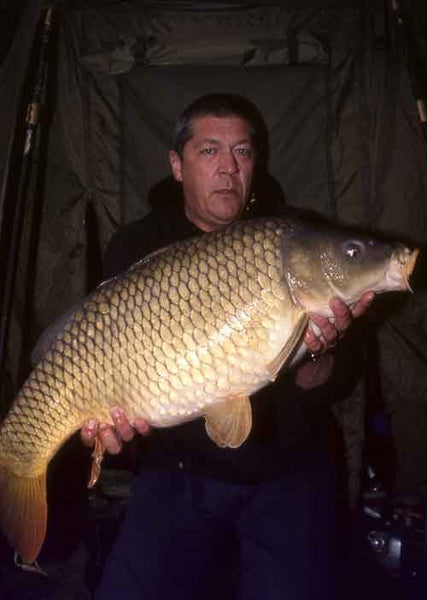
Keep safe and well.
written by ken Townley.
